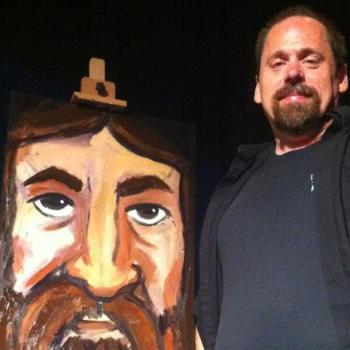
Did you ever think of the spiritual implications of a monarch butterfly? A few years ago, a couple came into my church, Matt and Charlotte Kulp. Their hobby is raising monarch butterflies—upward of 500 a year. They wanted to tell the world about their hobby, share the Gospel and generate awareness, so they started a YouTube channel called Monarch Miracles. They also decided to do a presentation for churches and civic groups and asked me to help them create the visual presentation. As a result, I learned a huge amount from the Kulp’s about these amazing creatures, and the more I learned, the more I learned, the more I saw monarch butterflies as a kind of living parable—representing the change Jesus makes in us.
Monarch Butterflies: A New Creation
Now admittedly, I had known some of this before. There’s a verse in the Bible that feels almost autobiographical for me. 2 Corinthians 5:17 “Therefore if anyone is in Christ, he is a new creation, the old has gone, the new has come.” I loved this verse so much that when my wife and I, with a few friends, planted a church, we called it New Creation Fellowship. Our symbol was a butterfly. The more I delved into the lifecycle of the butterfly, the more parallels I saw between their transformation, and our lives in Christ. The Monarch Butterfly is a living parable, showing us images of our journey with Christ
Monarch Butterflies: Metamorphosis
I believe it was my seventh grade science teacher Mr. Scott Clay who taught me that a metamorphosis is a complete change. That’s what this verse speaks to. Following Christ is supposed to change you from the inside out. It’s supposed to be transformational. Jesus comes in and takes the best of you and changes the rest of you. The Spirit of the living God comes into your life and that can’t help but make a change. So let’s look at the butterfly, specifically the monarch, and see how this living parable, relates to a life in Christ.
Monarch Butterflies: The Journey Begins
Monarch butterflies start their lifecycle as an egg. My friend Charlotte has often tried to show me the eggs. Occasionally I can see them, the rest of the time, I have to take it on faith that she sees them. The eggs are tiny and with good reason. The female monarch, in her short time on earth as a butterfly, two to five weeks, will lay between 300 and 500 eggs. While they are very small in size, they hold within them everything needed to make a full grown butterfly. Similarly God has a good plan and purpose for our lives, and I believe He has equipped us with everything we need to fulfill that plan, and anything that might be missing, He will provide at just the right time.
Monarch Butterflies: The Milkweed Connection
The female monarch will lay her eggs on only one kind of plant, milkweed. It is the only thing monarch caterpillars can eat, and they eat voraciously. When the caterpillar first emerges from the egg, he looks like a very small rice noodle with a black dot for a head. The caterpillar’s growth is exponential. He grows so fast that he stops to shed his skin five times. To put this in perspective, the caterpillar is only a caterpillar for about two weeks. During those five sheds, he will stop eating, shed the skin and eat it, and then commence with eating leaves.
Our Spiritual Food
The Monarch Butterfly is a living parable, showing us images of our journey with Christ. Now of course we humans can eat many things, but remember this is not a direct comparison. It’s a spiritual one. While we can be sustained physically by a wide range of foods, our spiritual sustenance, should come from God and His Word and if we try to sustain our spirits with anything else, it will be detrimental.
Monarchs and Milkweed Continued
One of the reasons the caterpillars thrive on milkweed is derived from the reason it’s called Milkweed. Crack a milkweed leaf in half, and you will see a white milky sap that comes out. That sap is very bitter, and since it is the only diet of the caterpillar, the caterpillar himself becomes very bitter, which is great for warding off certain predators. The caterpillar grows into a striped wormy looking bug. As worms go, it’s an attractive worm, but still a worm. He’s already experienced tremendous growth, but of course God’s final intent for him is not to be a worm crawling around with a belly full of bitterness. God has something better in mind. Similarly God doesn’t intend for us to crawl through this world with a belly full of bitterness either. He has something better for us too.
Things are Looking Up
Somehow, and God only knows how, at some point the butterfly begins to see a need for a change, and to make that change he has to rise above. So he starts to climb. Have you ever felt the need to change? Keep reading. He climbs up higher, high enough to hang upside down. Butterflies don’t spin a cocoon. That is reserved for moths, but the butterfly will spin a little bit of silk out his bottom from which to hang. So in essence what you have is a creature in need of a change, hanging by a thread. Now can you relate?
Painful Change
Hanging by the thread, his body contorts into the form of a letter J. Some say that is a J for Jesus. The principle works in English and a few other languages, but in his “native language” Jesus’ name is Yeshua Hamaschiach, and there the principle falls apart. Nevertheless, if you see this animal in need of a change and hanging from a thread and him being in a J shape and it reminds you to look to Jesus in your tough moments, I’m okay with that. Hanging in that form, he starts to writhe and wriggle. It looks painful but that relates to us as well. Often when we find ourselves in need of Jesus, it comes in the midst of a painful experience. In those moments we need to hang in there because change is coming.
What Lies Beneath
For the caterpillar, writhing and wriggling, eventually his skin splits open and falls away revealing what lies beneath. When the skin splits completely away what remains is a bright green shape, called a Chrysalis. Within that Chrysalis, what is left of the caterpillar is broken down into almost an ooze, but that’s okay because transformation is happening and he is being completely remade. Often our transformation also comes about as a result of being broken down as well.
The Monarch Gets His Crown
One of the beautiful features of a monarch chrysalis, is a ring of shiny metallic gold around the top, along with several golden dots at the bottom. It reminded the artist in me of a crown. Perhaps that’s why it’s called a monarch. That is not the case. It turns out the monarch gets his name from a real monarch—King William III of England. Before he was king, he was a prince, and his title was Prince of Orange, hence the beautiful orange butterfly’s name. Scientists say that the gold elements on the chrysalis may be a kind of air vent letting oxygen in for the transformation. That being said, the gold band still reminds me of a crown, and maybe that could remind us that when we come to Jesus, we become not just new creations, but children of the king.
The Process Is Nearly Complete
When the butterfly is nearly ready to emerge, the green chrysalis appears to turn black. That’s not really the case. The black that you’re seeing is the black of the wings and the chrysalis has become transparent. There is a lot of wiggling around and the butterfly prepares to break free. At this point there would be a real temptation to help him. Resist that temptation. The struggle to break free strengthens the butterfly. To help him would be to weaken and perhaps even kill him. Similarly, the struggles of our lives can strengthen us. Our temptation is always to try to protect people we love from struggles and something that can be equally destructive.
Spreading His Wings
When the butterfly first breaks free, he looks like a disaster. His abdomen is huge and distended and his wings are tiny. It looks like there is no way he will ever fly. This can be reminiscent of when we first come to Christ. There is a complete change but some further development is required before. The butterfly’s abdomen needs to contract which will push the fluids held within into the wings. Slowly over time, the wings grow to the beautiful form we know and love and the butterfly is complete. Sometimes we as believers need some time to spread our wings as well.
Metamorphosis
By now the transformation is complete, That little worm is now a new creation. Where before he had six stubby working legs and ten “prolegs” used to help the caterpillar move along, now he has six long slender legs. Where he once had six eyes, now he has twelve. Believe it or not, both the caterpillar and the butterfly had a three sectioned body, the shape is completely different. When’re before he ate only milkweed, he will never eat milkweed or any other solid food ever again. For the rest of his life, he will eat nothing but nectar. Add to all that the wings and you have the complete transformation—the new creation. Jesus makes many changes in us as well. We were never designed to crawl through this life with bellies full of bitterness. No we were made to feed on the sweet nectar of God’s love and one more thing. We were made to rise above, We were made to soar!
One Last Thing…
Butterflies have a short life—two weeks from egg to chrysalis, two weeks in the chrysalis, and two to five weeks as a butterfly—a full life of six to ten weeks. This means the butterflies you see at the beginning of the season are not the same as the ones at the end of the season. They are the grandchildren, maybe even great grandchildren of Summer’s first butterflies. All Summer long they live six to ten weeks, but the last generation lives substantially longer. As the Autumn air starts to cool, the butterflies begin to fly. They fly all the way to Mexico. They spend the Winter in Mexico, huddled together for warmth all winter long. Then with the warm Spring air, those same butterflies make the long migration to the north to start the process all over again. Living four times or more as long as their summer ancestors.
What This Means to You
The Monarch Butterfly is a living parable, showing us images of our journey with Christ. That fall butterfly somehow knows how to travel thousands of miles to a place where he has never been before. How does He know? The only real answer is God has shown him the way. Similarly in our journey of life in Christ, there comes a time when we will make a journey to some place we have never been before and there we will live forever. We can know the way because the way is a person. Jesus Christ. Yes, He makes us new creations. Yes, He gives us the right to become children of God, children of the King, but one last thing. He is the way the truth and the life, and no one comes to the Father, apart from Him. He is the way to eternal life.
Made for More
We were not made to crawl through this world with bellies full of bitterness. We were made to soar. We were meant to be new creations and children of the King. We were meant to feast on the sweet nectar of God’s love and we were made to soar all the way home, following the One who is the Way! Following Him in this world is not always easy. The transformation changes what we desire, and sometimes that makes it hard to fit in with the rest of the world. C.S. Lewis covered that. He wrote, “If I find in myself desires which nothing in this world can satisfy, the only logical explanation is that I was made for another world.” Let Jesus transform you, follow Him, live for Him in this world and remember this world is not our home. Let Him make you a new creation













